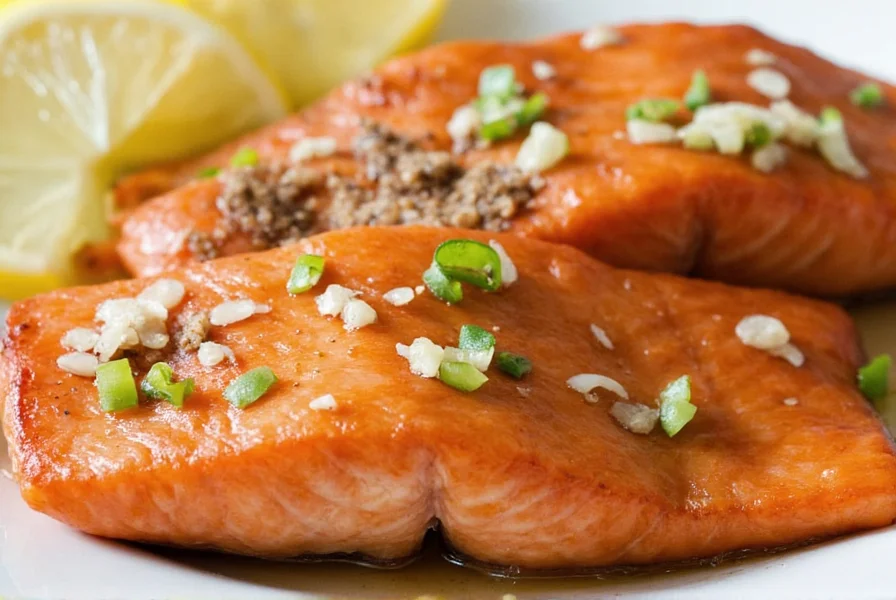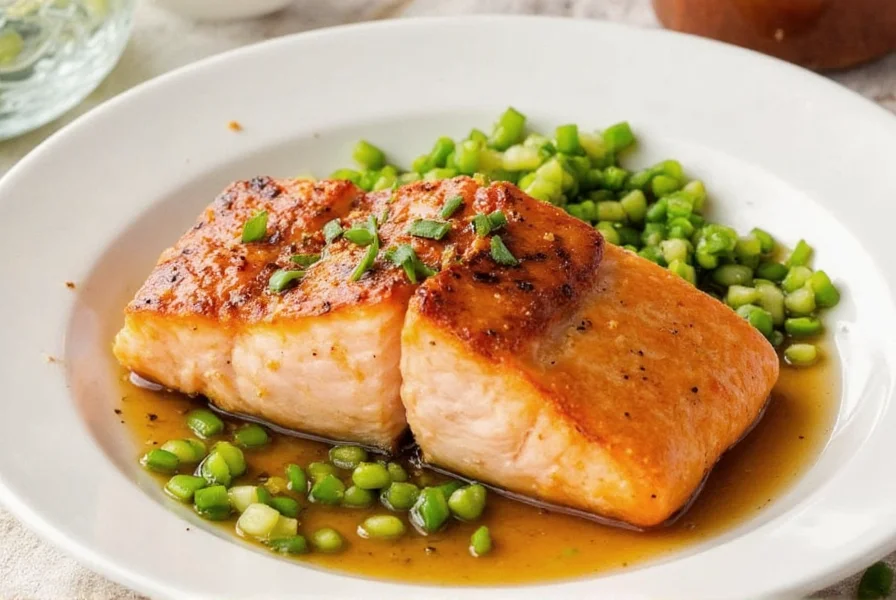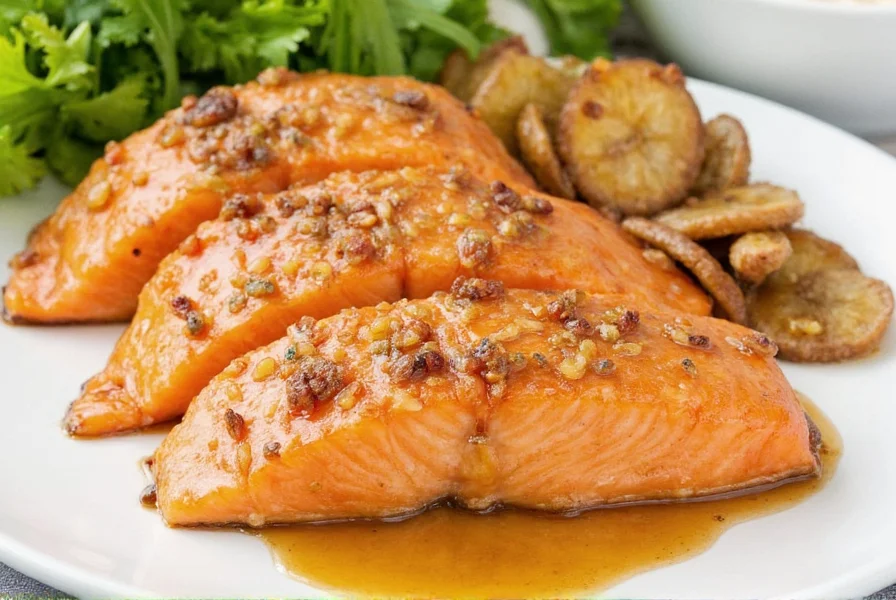If you're looking for a quick, nutritious dinner that delivers restaurant-quality flavor, ginger soy salmon should be at the top of your menu. This versatile dish combines the omega-3 rich benefits of salmon with a marinade that balances salty, sweet, and aromatic elements. The magic happens when fresh ginger's zesty warmth meets premium soy sauce, creating a glaze that caramelizes beautifully during cooking while keeping the fish moist and tender.
Why Ginger Soy Salmon Works So Well
The culinary chemistry behind this popular dish explains its widespread appeal. Salmon's natural oil content stands up beautifully to bold flavors without becoming greasy. When you combine fresh ginger's bright, slightly spicy notes with soy sauce's deep umami richness, you create a marinade that penetrates the fish just enough to enhance rather than overwhelm. The natural sugars in the marinade caramelize during cooking, forming that irresistible glossy finish that makes ginger soy salmon visually stunning and delicious.
Essential Ingredients for Perfect Ginger Soy Salmon
Quality ingredients make all the difference in this seemingly simple dish. Don't substitute key components if you want authentic flavor and texture.
| Ingredient | Why It Matters | Recommended Quantity (per 6oz fillet) |
|---|---|---|
| Fresh salmon fillet | Wild-caught provides superior flavor and texture | 6-8 oz |
| Low-sodium soy sauce | Prevents oversalting while delivering rich umami | 2 tablespoons |
| Fresh ginger (grated) | Provides bright, authentic flavor (powder won't compare) | 1 tablespoon |
| Garlic (minced) | Complements ginger without overpowering | 1 clove |
| Honey or maple syrup | Creates perfect caramelization during cooking | 1 tablespoon |
| Sesame oil | Adds nutty depth (use toasted for best results) | 1 teaspoon |
Step-by-Step Preparation Guide
Follow these professional techniques to achieve perfectly cooked ginger soy salmon every time:
- Prepare the marinade: Whisk together 2 tablespoons low-sodium soy sauce, 1 tablespoon freshly grated ginger, 1 minced garlic clove, 1 tablespoon honey, and 1 teaspoon toasted sesame oil in a shallow dish.
- Marinate the salmon: Place salmon fillets skin-side down in the marinade. Cover and refrigerate for 15-20 minutes (no longer, as the acid can start to "cook" the fish).
- Pat dry thoroughly: Remove salmon from marinade and pat completely dry with paper towels. This critical step ensures proper searing.
- Heat your pan: Use a heavy-bottomed skillet over medium-high heat until a drop of water sizzles on contact.
- Sear skin-side down: Place salmon skin-side down in the hot pan with 1 tablespoon neutral oil. Press gently with a spatula for even contact.
- Cook to perfection: Sear for 5-6 minutes until skin is crispy and golden. Flip and cook 2-3 minutes more until internal temperature reaches 125°F for medium-rare.
- Finish with glaze: Return pan to low heat, add reserved marinade, and cook 1 minute until slightly thickened. Spoon over salmon.

Cooking Method Variations
While pan-searing delivers the best texture, these alternative methods work well for different situations:
- Baked ginger soy salmon: Preheat oven to 400°F. Place marinated salmon on parchment-lined baking sheet. Bake 12-15 minutes until flaky. Best for meal prep or cooking multiple portions.
- Grilled ginger soy salmon: Oil grill grates well. Cook skin-side down over medium heat 6-8 minutes, flip and cook 2-3 minutes. Adds wonderful smoky notes.
- Broiled ginger soy salmon: Position rack 6 inches from broiler. Broil 6-8 minutes until caramelized. Watch carefully to prevent burning.
Pro Tips for Restaurant-Quality Results
Professional chefs rely on these techniques to elevate their ginger soy salmon:
- Always bring salmon to room temperature before cooking for even results
- Use a digital thermometer to check doneness (125°F for medium-rare, 135°F for medium)
- Reserve some marinade before adding to raw fish for finishing the cooked dish
- Add a splash of rice vinegar to the marinade for brighter flavor balance
- Sprinkle with sesame seeds and sliced green onions immediately before serving
Perfect Pairings for Ginger Soy Salmon
This versatile dish complements many side dishes. Choose based on your meal goals:
- Healthy meal prep: Serve with roasted broccoli and cauliflower rice
- Weeknight family dinner: Pair with jasmine rice and steamed snap peas
- Elegant entertaining: Accompany with wasabi mashed potatoes and asparagus spears
- Low-carb option: Serve over zucchini noodles with sautéed mushrooms

Storage and Reheating Guidelines
Proper storage maintains both food safety and quality:
- Refrigerate leftovers within 2 hours in an airtight container
- Consume within 2 days for best quality
- To reheat: Place salmon on parchment-lined baking sheet, cover loosely with foil, and warm in 275°F oven for 8-10 minutes until internal temperature reaches 120°F
- Never microwave salmon as it becomes rubbery and loses texture
Common Mistakes to Avoid
Even experienced cooks make these errors with ginger soy salmon:
- Over-marinating: More than 30 minutes makes the texture mushy
- Wet fish before searing: Failing to pat dry causes steaming instead of searing
- Overcrowding the pan: Lowers temperature and prevents proper caramelization
- Flipping too soon: Wait until salmon releases naturally from the pan
- Using low-quality soy sauce: Premium brands make a noticeable difference
Frequently Asked Questions
Can I use frozen salmon for ginger soy salmon?
Yes, but thaw frozen salmon properly in the refrigerator for 24 hours before use. Never cook frozen salmon for this recipe as it won't absorb the marinade properly and will release too much water during cooking. Pat thawed salmon extra dry to compensate for any moisture from freezing.
How do I prevent my ginger soy salmon from sticking to the pan?
Ensure your pan is properly preheated before adding oil, then wait until the oil shimmers before adding the salmon. Use a heavy-bottomed stainless steel or cast iron skillet, and make absolutely certain the salmon is completely dry before placing it in the pan. Don't move the salmon until it naturally releases from the pan surface, which typically takes 4-5 minutes.
What's the best soy sauce for ginger soy salmon?
For authentic flavor, use a Japanese-style soy sauce like Kikkoman or Yamasa. These have a more balanced flavor profile than Chinese soy sauces. Low-sodium versions give you better control over salt content. For premium results, try artisanal brands like Lee & Perrins or San-J Organic. Avoid "light" soy sauces as they're actually saltier and more chemically processed.
Can I make ginger soy salmon ahead of time for meal prep?
Yes, but with important caveats. Marinate the salmon for no more than 20 minutes, then store the uncooked marinated salmon in a separate container from the extra marinade. Cook just before eating for best texture. Alternatively, cook the salmon completely, cool quickly, and store with a small amount of fresh sauce separate from the fish to prevent sogginess when reheating.
Why is my ginger soy salmon turning out too salty?
This typically happens when using regular soy sauce instead of low-sodium, marinating too long, or not balancing the salt with sufficient sweet elements. Try reducing soy sauce by 25% and increasing honey or maple syrup proportionally. Also ensure you're using fresh ginger rather than powdered, which can make the flavor profile seem sharper and saltier.











 浙公网安备
33010002000092号
浙公网安备
33010002000092号 浙B2-20120091-4
浙B2-20120091-4